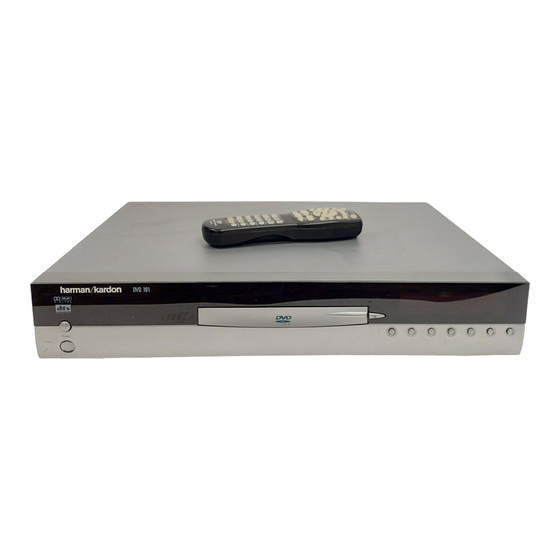
Harman Kardon DVD 101 Brochure
Harman kardon dvd 101: product brochure
Hide thumbs
Also See for DVD 101:
- Owner's manual (36 pages) ,
- Brochure (1 page) ,
- Reference manual (1 page)
Advertisement
Power for the Digital Revolution
MP3 Decoding in Harman Kardon Products.
Harman Kardon has long been a technological leader in the audio industry, with a
long list of "firsts" that includes the first stereo receiver, the first use of Dolby* Type B
noise reduction in a cassette player and, more recently, the world's first receiver
to feature Logic 7
®
and VMAx
path receivers. Continuing this tradition of innovation, Harman Kardon was the first
brand to fully embrace MP3 technology by offering MP3 playback in both a
DVD player and a CD-R/RW recorder. Harman Kardon's audio/video receivers are
the first to integrate MP3 with built-in decoding and both coaxial and optical front-
panel digital inputs. Now, enjoying the wide variety of MP3 audio content is as
simple as playing an MP3-encoded CD in a DVD 25 or DVD 101, or connecting
the output of a compatible computer sound card to the digital input of an
AVR 325, AVR 525, AVR 7200, DPR 1001 or DPR 2001.
The Basics of MP3 Audio
From a technical definition standpoint, what is popularly referred to as "MP3" is more precisely the "Level 3" format
for recording audio in the MPEG-1 video compression standard. In simple terms, this means that an MP3 file is a
digitally compressed version of an audio track. The original audio may be a file initially created for distribution in the
MP3 form, or it may be created from an existing source, such as a CD. The difference between standard digital
audio files and an MP3 file is that the average 3-minute song takes up about 32 megabytes of space, but the MP3
takes up considerably less memory, enabling more songs to be placed on a single disc or memory card, with little
compromise in sound quality. The compression process relies on oddities of human perceptions of sound. For
example, louder sounds mask softer sounds so that we don't hear them, and sometimes the same material is
repeated in both channels of a stereo recording.
MP3 is changing the face of music distribution, as the smaller file size makes it possible to distribute audio over the
Internet without the lengthy download times that would be required if the files were in their original, uncompressed
size. The availability of MP3-encoded music has also made it possible for consumers to exchange songs via the
Internet, or store their CD libraries on a computer. These files may be transferred to a portable MP3 player that uses
solid-state storage or mini-drives, and if the computer is equipped with a CD-R/RW drive, the MP3 files may also be
used to record "MP3 discs. " These discs may be played on computers or specially equipped CD or DVD players,
such as the DVD 25. Finally, MP3 may also be used for the playback of streaming audio programming in real time.
®
digital audio processing, and the world's first digital
®
.
®
Advertisement
Table of Contents

Summary of Contents for Harman Kardon DVD 101
- Page 1 Now, enjoying the wide variety of MP3 audio content is as simple as playing an MP3-encoded CD in a DVD 25 or DVD 101, or connecting the output of a compatible computer sound card to the digital input of an AVR 325, AVR 525, AVR 7200, DPR 1001 or DPR 2001.
- Page 2 ANY audio system. With a single MP3 disc able to hold about 10 hours of music in the MP3 format, the DVD 25 and DVD 101 can keep the party going all night with just one button press.












Need help?
Do you have a question about the DVD 101 and is the answer not in the manual?
Questions and answers